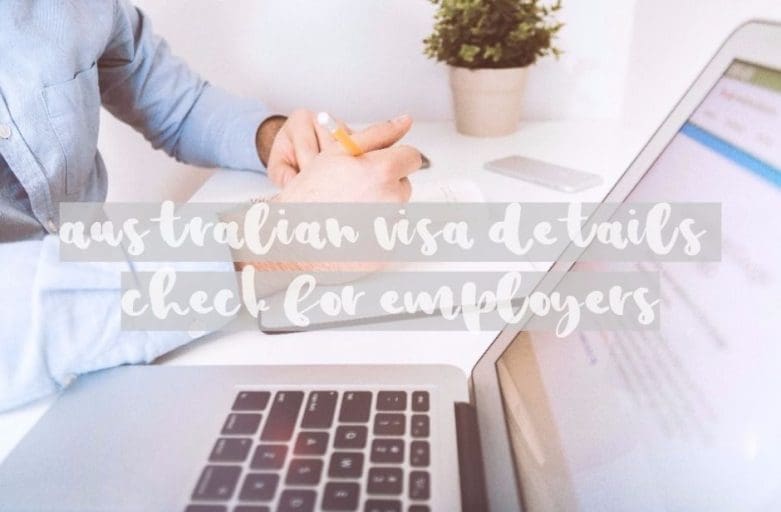Checking employees visa details
Business entities and other organizations in the country that are employing workers from overseas always grapple with this question: Is my business at risk when employees change visas?
And if you happen to be an owner or a manager of such a company or organization, this question always pops up in your mind, at least should – if in doubt it is always the best idea to talk to a professional – a migration agent who can check the work entitlements of your prospective employee and explain you all the conditions of his or her visa. Give us a call if you need any advice.
But before we go any further as to the ramifications of an employee changing visas while still working for you, let’s discuss first checking of visa details using VEVO.
The problem, though, is it’s easier said than done: the act of checking the details of each and every visa of the people under your care and the visas of your applicants proves to be a laborious process, what with the number of visas you had to look into. Add to that the fact that there are many types of visas issued by the Australian government. On top of that, each type of visa contains various conditions and limitations.
Imagine yourself running a business and attending to the visa concerns of your overseas hires. It’s arduous, to say the least.
VEVO makes your life easier
But with VEVO, you can now kiss goodbye to that one pain in your neck. But, before anything else, what is VEVO?
VEVO stands for Visa Entitlement Verification Online. As the name connotes, it is an online facility of the Department of Immigration and Border Protection (DIBP) used in checking the current visa details of your workers and job-seeking visa holders.
You don’t need to register to the app or program to be able to use it. All you need are the details of the passport or ImmiCard and one of the reference numbers that the DIBP gives you. The reference number can be any of these:
- Transaction Reference Number (TRN)
- visa grant number
- visa evidence number
- password
How does VEVO work?
Having the details of the passport or ImmiCard of your worker or an applicant, together with the reference number, you can now open the VEVO service by accessing VEVO for Visa Holders.
Please don’t forget to check the box reserved for your agreement to VEVO’s terms and conditions and then click the Submit button.
After that, choose the reference number type you prefer to use. You can use the pull-down menu for this purpose and click the field that contains your choice.
The next thing you need to do is to enter the date of birth, passport or ImmiCard number and the country that issued the passport. If you are using the ImmiCard, you have to choose Australia. There’s another pull-down menu for this purpose that you can use.
What can you search at VEVO?
If you access VEVO, you can find the following information related to your visa or the visas of your employees:
- Category selected
- Visa description (temporary, permanent)
- Passport/immicard number
- Visa class subclass
- Visa holder type – primary or secondary applicant
- Visa grant date
- Visa expiry date
- Current Location either inside or outside of Australia
- Visa status
- Entries allowed
- Initial stay date
- Must not arrive after
- Enter before date
- Purpose of stay
- All conditions applicable to your visa in plain English
Please take note, however, that VEVO only provides details for current visas. It cannot provide data on previous visas. Moreover, you can only use the service if the information on the visa you’re checking is available electronically in the systems. Otherwise, your effort becomes futile.
In fact, there are foreign nationals, especially the permanent residents that migrated to the country before the 1990s and have not gone out since, who may not have record in the department’s systems.
How VEVO looks like
The entries on page one of VEVO appears similar among all types of visas. We are referring to the searchable information listed above such as visa class or subclass, visa description, visa grant date, etc.
The major differences come on page two and the succeeding pages if any. Page two onwards contains the conditions attached to a particular type of visa – for instance, the activities that the visa holder can and cannot do while staying here, their work rights, the time limitations, and so on.
Let’s take, for example, working holiday visa (417). We know that this visa is a short-term, temporary visa with time limits. In particular, it is valid for 12 months.
On the second page of VEVO for working holiday visa, these details will appear:
- Condition number 8547 — In the case of 417, the holder must not be employed by one employer by more than 6 months without prior written permission from the Secretary.
- Condition number 8546 – the holder must not engage in any studies or training for more than 4 months.
Another example that we can cite here for the purpose of demonstrating the usefulness of the online facility is the student visa. Again, the first page of VEVO looks the same as that of the working holiday visa. But the similarity ends there: the student visa has 2nd and 3rd pages containing visa limitations. And, more often than not, the limitations revolve around employment. The most prominent condition here says: The student must not engage in employment when studies have not commenced yet.
You can also find here an explanation about the fortnight, namely that it consists of 14 days starting on a Monday.
Yet another type of visa that we can use as an example in our discussion is another kind of student visa, but this time the holder is a secondary applicant. In this case the name of the primary or main visa holder should appear in the VEVO.
Common Issues on Visa Conditions and Visa Change
It’s worth discussing Partner Visa in this article because of that type (of partner visa) that gives provisional condition to the holder to stay in Australia. And the operating word here is PROVISIONAL.
This type of partner visa is issued for the purpose of meeting eligibility requirement. The permanent type of partner visa may be granted two years after the temporary one has been issued to make sure the relationship between the visa holder and the sponsor or main applicant is genuine.
One entry on the visa that you have to watch out for is whether the visa holder is the primary or secondary applicant. A secondary visa holder who’s working for you may pose some issues later especially when the primary or main visa holder decides to break up with the dependent visa holder such as a spouse or partner.
Generally, the main visa holder would report to the department the breakdown in relationship and the department would cancel the visa of the dependent. In most cases, you wouldn’t have any idea about this occurrence.
Bridging visa may also pose some issues among your visa-holding population. This visa is issued when a substantive visa expires and the application for another substantive visa has not been granted yet.
Let’s always keep in mind that bridging visas are not always automatic when it comes to transferring the work rights of the holder from the expired substantive visa to the bridging visas, hence it is always wise to check the status of the bridging visa online.
There’s also the concern about where to work in Australia. Certain visas allow holders to work only in regional Australia like RSMS visa subclass 187. It goes without saying holders of subclass 187 cannot take on occupations in areas not included in the regional postcodes.
Another factor worth looking into concerns the computation of the six-month limitation on working holiday visa.
In all of these situations, it is highly suggested that you check the details of the visas your employees are holding so as to avoid complications with the department.
In our experience, most employers, like you, understand the need to check visa details but find no time to monitor them once employment starts.
We cannot highlight enough the extreme importance of the process of checking the status of the employees’ visa. The good news is, you now have VEVO at your disposal.
Price of non-compliance
Migration Act deems it a criminal offense on your part to willingly and recklessly allow an illegal non-citizen to work and continue to work in your organization or company in breach condition.
Who are considered illegal non-citizens? They are:
- Non-citizens who do not have a visa
- Non-citizens who have a visa but are working in breach of the conditions of the visa they’re holding. An example of this is a visit visa holder who has no work right but is still allowed to work.
If the department finds you guilty of non-compliance with Migration Act, the consequences vary from relatively minor punishments like enforcement of infringement notices or civil penalties with financial implications to major outcomes such as criminal prosecution.
How to manage compliance issues
One basic recommendation that we can put forward is for you to maintain an updated database of your visa holding workforce. This does not only contain the visa descriptions or expiry dates of the visas but should include vital information such as their work rights, visa conditions, etc.
You may also require your employees to inform a particular person in the organization concerning changes to visa status. In relation to this, you may get permission from them to check the status of their visas regularly. Furthermore, we recommend that you do it not less than every three months.
For those individuals who are on bridging visa and those who have informed you that their visas are still pending, you may monitor them every 28 days.
Many questions still beg to be answered as regards checking visa status on VEVO and the possible risks on your business or organization of employees changing from one type of visa to the other. We know so much is at stake here if you miss addressing some vital issues in the process.
For this reason, we invite you to get in touch with us at Nowak Migration. This way, we can have more time to discuss your concerns.
If you find this article helpful and informative, please share it with your friends and family. We will certainly appreciate it.



